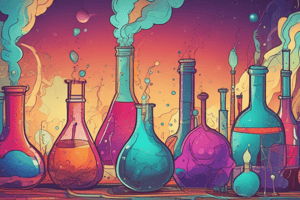Podcast
Questions and Answers
What is the primary function of energy in living organisms?
What is the primary function of energy in living organisms?
- To perform different sustaining functions (correct)
- To facilitate chemical reactions
- To transfer thermal energy between substances
- To facilitate the law of conservation of mass
What is the study of energy relationships in chemical reactions known as?
What is the study of energy relationships in chemical reactions known as?
- Stoichiometry
- Energy Conservation
- Thermochemistry (correct)
- Chemical Thermodynamics
What is the difference between temperature and heat?
What is the difference between temperature and heat?
- Temperature is the process of transferring energy, while heat is the manifestation of thermal energy
- Temperature is the manifestation of thermal energy, while heat is the process of transferring that energy (correct)
- Temperature is the energy involved in random motions, while heat is the process of transferring energy
- Temperature is the energy transferred between substances, while heat is the manifestation of thermal energy
What is the fundamental law that governs the relationships between energy in chemical reactions?
What is the fundamental law that governs the relationships between energy in chemical reactions?
What is the term for the energy involved in the random motions of atoms and molecules?
What is the term for the energy involved in the random motions of atoms and molecules?
What is the unit of energy in the International System of Units (SI)?
What is the unit of energy in the International System of Units (SI)?
What type of system allows exchange of both matter and energy with its surroundings?
What type of system allows exchange of both matter and energy with its surroundings?
What is the term for a chemical reaction that releases energy to the surroundings?
What is the term for a chemical reaction that releases energy to the surroundings?
What is the term for a property of a system that depends only on the initial and final states of the system?
What is the term for a property of a system that depends only on the initial and final states of the system?
What is the sum of the potential and kinetic energies in a system?
What is the sum of the potential and kinetic energies in a system?
Study Notes
Energy and Thermodynamics
- Energy is the ability to do work and is essential for life and modern society.
- Energy is used by every living organism to perform different sustaining functions.
- In chemistry, energy comes from chemical reactions, which obey the law of conservation of mass and the law of conservation of energy.
The First Law of Thermodynamics
- The energy relationships and changes involved in chemical reactions are as important as mass relationships when studying matter.
- Most chemical reactions occur with the absorption or release of energy in the form of heat.
- Heat is the transfer of thermal energy between substances or matter at different temperatures.
Thermal Energy and Temperature
- Temperature is distinct from heat; it is defined as the manifestation of thermal energy.
- Thermal energy is the energy involved in the random motions of atoms and molecules.
Thermochemistry
- Thermochemistry is the study of energy changes in chemical reactions, typically in Joules (J), the SI unit of energy.
- The field involves quantities of heat and work.
Systems in Chemical Reactions
- The system is the part of the universe that is studied, and the rest of the universe is considered the surroundings.
- There are three types of systems: open systems, closed systems, and isolated systems.
Types of Energy Transfers
- Exothermic processes release energy to the surroundings, while endothermic processes absorb energy from the surroundings.
The First Law of Thermodynamics (continued)
- The first law of thermodynamics states that energy cannot be created nor destroyed, only converted from one form to another.
- The exact energy (internal energy) of a system cannot be determined, but changes in energy states can be determined.
Internal Energy
- The internal energy of a system is only concerned with the initial and final states, and it is a state function.
- The internal energy has two components: potential energy and kinetic energy.
- Potential energy is determined by the attractive and repulsive interactions of electrons and nuclei, as well as intermolecular interactions.
- Kinetic energy is described by the random molecular motions and electron movement within molecules.
Studying That Suits You
Use AI to generate personalized quizzes and flashcards to suit your learning preferences.
Description
Test your knowledge about the concept of energy and chemical reactions in chemistry. Explore the importance of energy in modern society and living organisms, as well as the fundamental laws governing chemical reactions.



